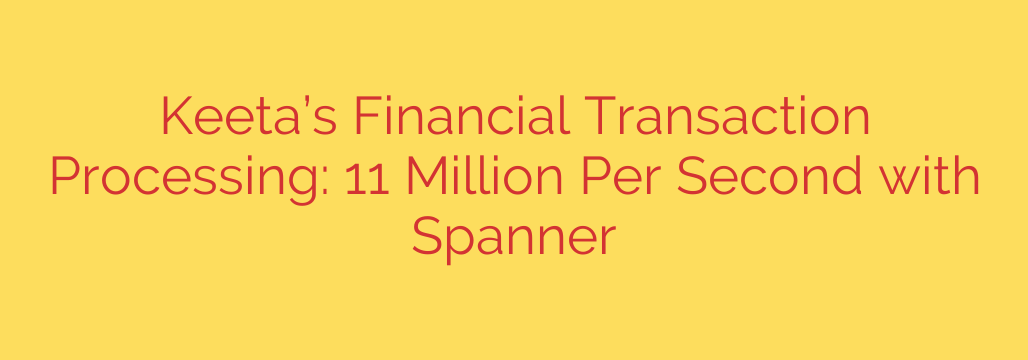
The Architecture Behind 11 Million Financial Transactions Per Second
In the world of financial technology, speed and reliability are everything. A fraction of a second can mean the difference between a successful transaction and a lost customer. That’s why the recent achievement of processing over 11 million financial transactions per second (TPS) represents a monumental leap forward, setting a new standard for what’s possible in digital finance.
This staggering figure isn’t just a vanity metric; it’s a direct response to the ever-increasing demands of the global digital economy. From high-frequency trading to worldwide e-commerce events like Black Friday, the need for an infrastructure that can handle massive, concurrent transaction volumes without faltering has never been more critical. Achieving this level of performance requires a sophisticated architecture built on cutting-edge technology. Let’s explore how this groundbreaking benchmark was reached and what it means for the future of financial services.
The Core Challenge: Balancing Speed, Scale, and Consistency
Processing financial transactions at scale presents a unique and difficult set of challenges. Unlike other data-heavy industries, finance has zero tolerance for error. Every transaction must be handled with perfect accuracy, which is governed by a principle known as ACID compliance (Atomicity, Consistency, Isolation, Durability).
- Atomicity: Ensures a transaction is all-or-nothing. It either completes successfully, or it fails and the system returns to its original state.
- Consistency: Guarantees that a transaction will only bring the database from one valid state to another, preventing data corruption.
- Isolation: Ensures that concurrent transactions do not interfere with each other, preventing issues like double-spending.
- Durability: Once a transaction is committed, it remains committed, even in the event of a system failure.
Historically, databases that offered strong ACID compliance struggled to scale horizontally (by adding more servers). Conversely, databases that scaled easily often had to sacrifice consistency—a trade-off that is unacceptable in finance. The central challenge was finding a way to achieve all three: massive scale, incredibly high speed, and ironclad consistency.
The Technological Breakthrough: Leveraging a Globally Distributed Database
The key to unlocking this performance lies in using a globally distributed SQL database like Google Cloud Spanner. Unlike traditional monolithic databases, Spanner was designed from the ground up to scale horizontally across multiple geographic regions while still providing the strong consistency required for financial ledgers.
This architecture solves the scaling problem by distributing the data and the processing load across thousands of machines. Here’s why this approach is so effective:
- Unlimited Horizontal Scalability: Instead of being limited by the power of a single server, a distributed database can grow its capacity by simply adding more nodes to the network. This allows it to handle virtually limitless transaction volumes.
- Strong Global Consistency: Spanner uses a unique combination of atomic clocks and GPS to ensure that every node in its global network has a precise, synchronized understanding of time. This enables it to enforce strict, ACID-compliant transaction ordering across the entire globe, eliminating the risk of data anomalies.
- High Availability and Fault Tolerance: By replicating data across multiple geographic locations, a distributed system ensures there is no single point of failure. If one data center experiences an outage, traffic is automatically rerouted to healthy regions, ensuring zero downtime for critical financial operations.
Key Strategies for Achieving Peak Performance
While the underlying database technology is crucial, hitting 11 million TPS also required meticulous optimization and architectural planning. The following strategies were essential:
Optimized Data Modeling: The database schema was designed specifically to avoid “hotspots”—single rows or tables that receive a disproportionate number of requests. By distributing data logically, such as sharding accounts by customer ID, the system ensures that read and write operations are spread evenly across the entire cluster.
Efficient Transaction Logic: The code responsible for processing transactions was streamlined to minimize the number of database round-trips. Each transaction was crafted to be as concise and efficient as possible, reducing lock contention and maximizing throughput.
Global Load Distribution: User traffic was intelligently routed to the nearest physical data center. This dramatically reduces network latency, which is a critical factor in overall transaction speed. A customer in Europe would have their transaction processed by a European server, while a customer in Asia would be routed to an Asian server, all while operating on the same globally consistent database.
Actionable Security and Reliability Tips for High-Volume Systems
Building a system capable of handling such extreme loads isn’t just about performance; it’s about trust. The security and reliability of the platform are paramount.
- Prioritize End-to-End Encryption: All data, whether at rest on a server or in transit over the network, must be encrypted using industry-standard protocols. This ensures that sensitive financial information is protected at every stage.
- Implement Robust Identity and Access Management (IAM): Enforce the principle of least privilege. Each component of the system should only have access to the specific resources it absolutely needs to perform its function.
- Conduct Continuous Performance Testing: Don’t wait for a major sales event to discover your system’s breaking point. Regularly simulate high-traffic scenarios to identify bottlenecks and validate that your scaling mechanisms are working as expected.
- Design for Failure: Assume that individual components will fail. Build automated recovery and failover processes to ensure that the system can withstand hardware failures, network issues, or even regional outages without impacting service availability.
The ability to process 11 million transactions per second is more than a technical milestone; it’s a paradigm shift. It proves that it is now possible to build financial systems that offer limitless scale and global reach without compromising on the consistency and reliability that underpin the entire financial industry. This opens the door to a new era of real-time global payments, more responsive financial applications, and a truly interconnected digital economy.
Source: https://cloud.google.com/blog/topics/financial-services/how-blockchain-network-keeta-processes-11-million-transactions-per-second-with-spanner/








